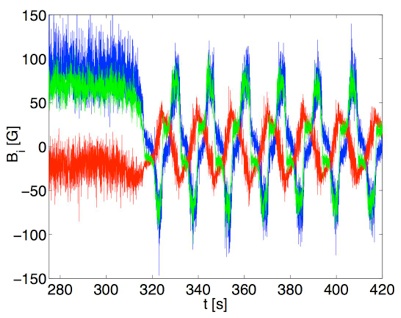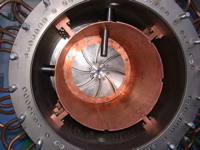Magnetohydrodynamics...
... and dynamo
In 1919, Larmor proposed that the magnetic field of the sun could be generated by the conversion of mechanical energy from the motion of a conducting fluid into magnetic energy. This statement has now been supported by theoretical, numerical and experimental investigations and is believed to be responsible for the generation of most astrophysical magnetic field including that of the Earth. The magnetic field of the Earth is supported by the motion of the liquid iron core. Only at the turn of the 21th century was it possible to obtain experimentally a self sustained magnetic field from the motion of liquid sodium. This was achieved almost at the same moment in Karlsruhe, Germany and Riga, Latvia.
The VKS collaboration
In France, the VKS collaboration also obtained a dynamo generation of magnetic field in liquid sodium in CEA Cadarache in 2006. This collaboration is composed of members of the CEA Saclay, ENS de Lyon and ENS de Paris (my former group until 2011). The difference between our experiment and the previous successes is that our flow is less constraint by walls and pipes so that the flow is free to be fully turbulent. In this respect, our experiment is closer to natural conditions but it is still pretty far from any natural object. Nevertheless a large variety of dynamical regimes was observed, including reversals looking very similar to that of the Earth.

The figure above is an example of time evolution of the components of the magnetic field in the VKS experiment. At times less than 310 s the dynamo is stationary in the sense that a non zero average magnetic field is observed with fluctuations around the average. At 310 s the frequencies of the driving impellers are changed leading the an oscillating dynamo. For more information see the bibliography.
Action of a magnetic field on a liquid metal flow
In order to study with more flexibility various magnetohydrodynamical processes involved in the dynamo, several experiments with water and gallium have been developed in the different groups composing the VKS collaboration. During his PhD, Michaël Berhanu developed a gallium flow entrained by propellers. We studied in particular the influence of a strong applied magnetic field on the statistics of the turbulent fluctuations. Because of the magnetic braking, the fluctuations are strongly damped. The dynamo is an instability of the magnetic field which leads to an exponential growth of the magnetic field. This growth is stopped when the generated magnetic field is strong enough to modify the flow by magnetic braking. If the turbulent fluctuations play a role in the generation of the dynamo then the damping of the turbulent fluctuations can cause the saturation of the dynamo.
See the Experimental Conference on the origin of the Earth magnetic field (in French) given by E. Dormy and N. Mordant





